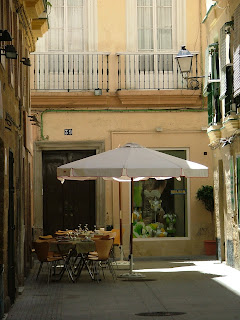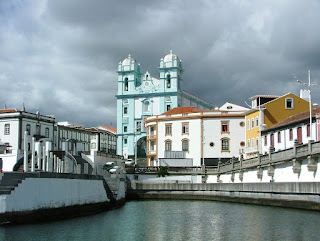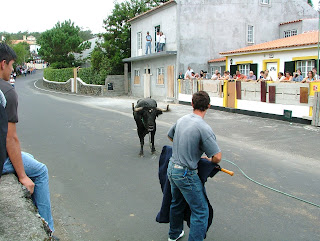



Where to begin? Our last proper update was from Cartagena – a stop we thoroughly enjoyed. Now we’re in Cadiz, another ancient (supposed to be the oldest in Europe) Phoenecian-founded city and, again, thoroughly enjoying it. Although the span of time in between is rather short, rather a lot has happened.
We pulled out of Cartagena around about three o’clock on a fine Wednesday afternoon. The sea was flat and we had a fine breeze on the beam wafting us westward. On the way out of the harbour, there was a small glitch when the winch for hoisting the main halyard stopped working. I knew they needed servicing, but not quite how urgently. Anyway, not really a problem. Conditions were pleasant and the main was hoisted, so we carried on under main alone while I stripped down, cleaned, greased, replaced pawl springs and reassembled the winch. We headed 15 or 20 miles offshore, to avoid tunny nets and shipping, and enjoyed an uneventful evening of simple sailing.
Around sunset, as often seems to happen, the wind died down, so we dropped the genoa and fired up Sven and were soon joined by a playful pod of dolphins. It’s impossible to tire of the company of these fun-loving animals. Just before dark, a tern circled the boat many times, almost alighting more than once, before flying off towards land.
12 hours later, we had 20 knots of wind again and we were running with double-reefed main and poled-out jib. Sadly, these conditions did not last and by the middle of the afternoon the wind had died completely. Sven was duly fired up only to conk out a few minutes later. There we were. 10 miles or so off Almerimad (the cheap British-dominated marina of Almerimar), no wind and now no engine, bobbing. Though the wind had stopped, the sea hadn’t and so we bobbed quite vigorously while I set about trouble-shooting the breakdown.
First thought was fuel supply, but there was plenty in the tank and cracking the line at the bleed point just before the injector and hand-cranking the engine showed there to be fuel present. Rope around the prop? A quick dive over the side showed this to be a false hope. Overheating or lack of lubrication causing piston to seize? Nope. Diesel injector clogged? After consulting the manual, I decided to pull it and check. Sure enough, the spray pattern didn’t look too good so I took it apart and found it to be a bit mucky inside. Following cleaning, reassembly and installation, I figured we’d be in good shape. No dice.
Finally, I decided to have a look at the fuel filter. I had been reluctant to do so, since it’s a damned diesely job and besides, I’d seen it only a few weeks ago, just before we launched, we hadn’t motored that much and I had only put in clean, quality fuel into the previously unused tank. As soon as I pulled it, however, the cause of our woes was revealed. Water! I’m still not sure how it got in there but my best theory is that it was condensation that had built up in the tank during Fettler’s long spell on the hard (should have checked this before putting fuel in for the first time). Anyway, this is a parameter that will be much more closely monitored hereafter. I found quite a bit of agua in the tank when I bled it out and then did all the fuel lines, replaced the filter, cleaned and reassembled everything once more and crossed fingers. That did it. Soon, Sven was happily put-putting away once more, sounding even better, I believe, for his newly cleaned injector.
There followed the longest motoring marathon in our sailing history – 45 hours, just the thing to clean out any residual droplets of water in the system. The wind seemed to have gone on strike for the next couple of days as we motored on across the eerily glassy sea. Dolphins visited us frequently during this time, by day and night, and I’ve seldom seen anything as beautiful as them playing by moonlight or, even better, after the moon had set and they were sheathed and trailing a bright glow of phosphorescence as they sported around the vessel. We were both on deck to marvel at this sight as the watch changed just before dawn.
Sometime between 0330 and 0400 that night, the log stopped reading. Something fouled around the paddlewheel, I supposed, so we decided to stop for a swim around 1000 and check it out. A bit of weed was the culprit, easily sorted. As we dried off in the cockpit afterwards, we were surprised by an odd blowing sound which turned out to be a pilot whale off the port quarter!
The motoring marathon went on. Just before noon (this is Friday now), when we were still 60 miles east of Gibraltar, we started to experience effects from the odd currents that flow there. We were plodding along with a knot and a half of foul current holding us back, when I noticed an odd line on the sea ahead. The line itself was a smooth band, with different ripple patterns on either side of it. As we crossed it, the foul current increased to two and a half knots. I immediately altered course towards shore and we crossed several such lines as we got closer in, until at last there was only one knot against us.
The main reason behind our big push for Gibraltar was the forecast we’d received in Cartagena. The winds were expected to hold easterly until Sunday and then swing around to the west. The geography of the Straits constrains the wind so that it almost always blows either due west or due east. Combined with the steady east-setting current and the tides, the practical effect of this on a small sailing vessel is that it is only really possible to get through, from east to west, with the wind behind you. We particularly wanted to avoid being bottled up at Gibraltar, waiting for the wind so we pressed on. Tide-wise, our timing was looking pretty good as we headed into Friday night. The best time to get through to the west is around 4 hours after high water Gibraltar, which would fall at 0700 on Saturday morning.
Sonja went off watch at 0100, just as visibility was starting to close down and we had 15 miles or so to go to Gibraltar. By 0200, we were shrouded in thick fog and I was navigating purely by radar and GPS, with periodic looks up on deck. There wasn’t much point in being up there, as I could only see a small circle of water around the boat and shipping was heavy in the approach to the Straits. At one point, just before Sonja woke up, I could see a dozen ships in the 3 mile range on the radar, some headed one way, some the other, some stationary, apparently riding at anchor. Several we passed within half a mile without being able to hear or see any sign of them. We passed the Europa light itself at a distance of one mile and couldn’t see a thing. In the end, we passed the Rock and crossed the boundary of the ancient world, through the pillars of Hercules, without even seeing it.
Sonja woke up as we were crossing the Bay of Gibraltar, had a near heart attack upon catching sight of the radar screen and now we both stayed on watch for the demanding passage through the Straights. Soon after we passed Gibraltar, the fog began to lift and a light breeze sprang up from the east. We were a couple of hours before the optimal time to pass through, but our speed over ground was reasonable and we decided it would be more hassle than it was worth to wait around.
Midway through I went down for a short nap and managed to grab half an hour before all Hell broke loose. Just as I came to, I heard a slightly anxious Sonja call down from the cockpit that the wind was picking up. Soon, as we approached Tarifa, the western extremity of the Straits and their narrowest point, the wind was blowing a near to full gale and the seas building quite fantastically.
Sven and Neville then went off duty and we ran before the gale with the double-reefed main out on a preventer and myself at the tiller. We had three knots of current against us and 30+ knots of wind behind, so the seas became very large and very steep in pretty short order. As one particularly vicious one slewed around, the wind got behind the mainsail and the boom whipped across with a bang. Accidental gibe – not good. The cleat that had been holding the preventer dropped into the cockpit, one screw broken off, the other simply ripped out. We had no option but to gibe a couple of times more, in a deliberate controlled manner, and to steer the course with great precision to avoid any further mishap.
Thankfully, as land fell away after passing Tarifa, so the wind and seas moderated rapidly and, though still rough, the danger was past.
It was a pair of tired but happy sailors who pulled into the unattractive and vaguely unpleasant port of Barbate a few hours later. The eventful 3-day passage from Cartagena was a challenge that left us with a great sense of achievement and the need for a good night’s sleep. Our satisfaction was heightened the following day when we learned that the wind had indeed come around to the west and was blowing a near gale the other way.- J
We then set out for Cadiz, hoping for a relaxing day sail. It was not to be – we had to fight for every inch of the way, with two knots of current against us, an unfavourable wind direction and horrible shoals that made for uncomfortable seas. We finally pulled in at the marina in Cadiz just before 2300, 11 hours after setting out for the 35-mile trip, and this despite doing over six knots the whole way.
Cadiz has a truly beautiful old town and we spent yesterday exploring its shady narrow streets and leafy squares. We will stay another two days here to recuperate before heading across the bay to sample some sherry at the port for Jerez and then continuing on to Portugal. - S






















































